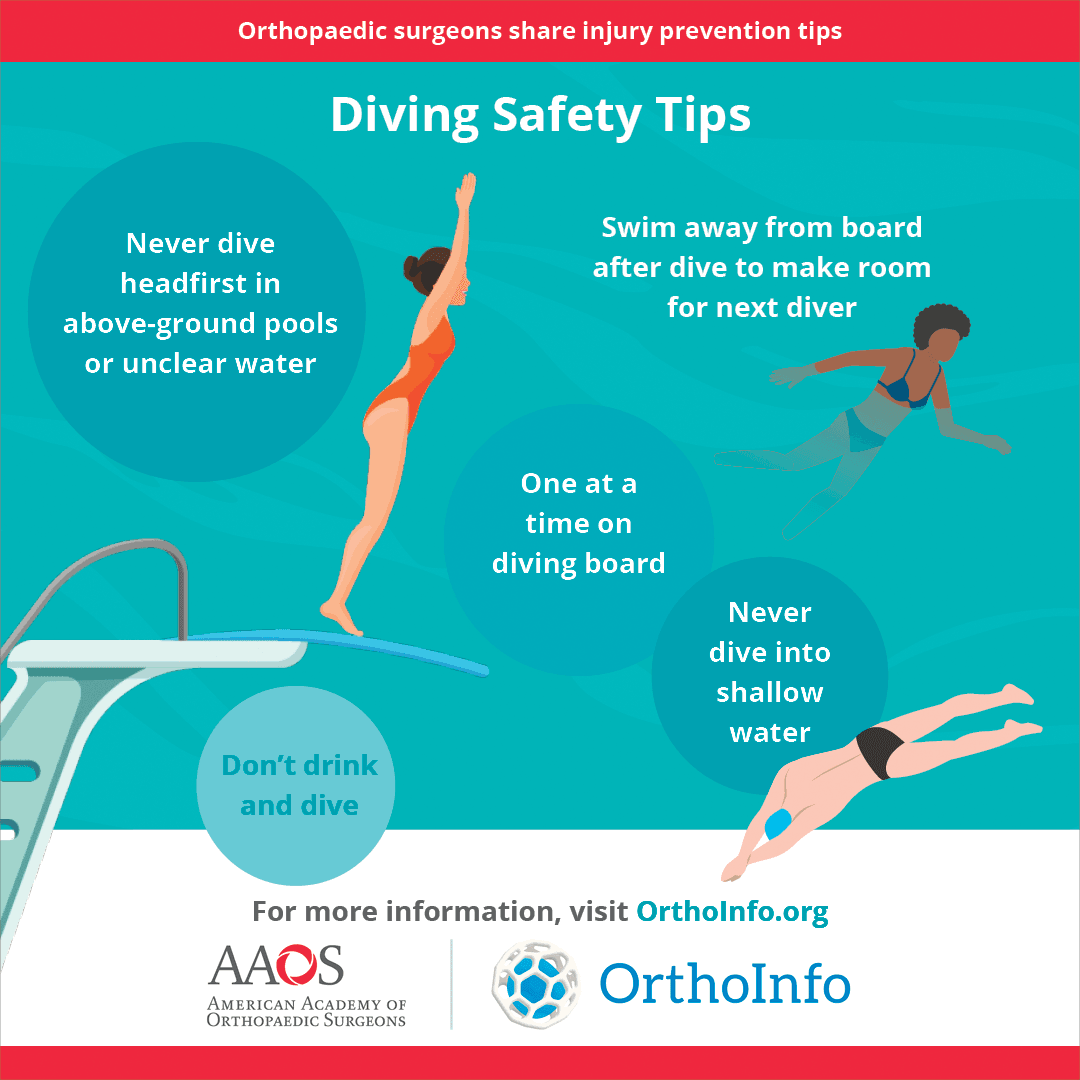Staying Healthy
Swimming Injury Prevention
More than 290,000 swimming-related injuries were treated in hospital emergency rooms, doctors' offices, and clinics in 2018 according to the U.S. Consumer Product Safety Commission. Many of these injuries might have been prevented by observing some simple safety precautions. Whether you swim for fitness or pleasure, you can help ensure that your time in the water is as safe and enjoyable as possible by following the injury prevention tips below.
General Guidelines
- Learn how to swim and do not swim alone. Swim in supervised areas where lifeguards are present. Inexperienced swimmers should wear lifejackets in the water.
- Do not attempt to swim if you are too tired, too cold, or overheated.
- When swimming in open water, never run and enter waves headfirst. Make sure the water is free of undercurrents and other hazards.
- Do not swim in a lake or river after a storm if the water seems to be rising or if there is flooding because currents may become strong. The clarity and depth of the water may have changed, and new hazards may be present.
- Check weather reports before going swimming to avoid being in the water during storms, fog, or high winds. Because water conducts electricity, it is dangerous to be in the water during an electrical storm.
- Remember that alcohol and water do not mix. Alcohol affects not only judgment, but it slows movement and impairs vision. It can reduce swimming skills and make it harder to stay warm.
- Be knowledgeable about first aid and be able to administer aid for minor injuries, such as facial cuts, bruises, or minor tendonitis, strains, or sprains.
- Prevent "swimmer's ear" by drying the ear canal with a cotton tip after swimming.
- Be prepared for emergency situations and have a plan to reach medical personnel to treat injuries such as concussions, dislocations, bruises, wrist or finger sprains, and fractures.
Diving Safety
More than 1,900 spinal cord injuries result from diving accidents every year. The majority of these injuries result in paralysis of all four limbs. To avoid injury, keep in mind the following tips when you dive:
- Do not dive in shallow water.
- Avoid diving into murky water. You should be able to see the bottom of a pool at the deepest point.
- Check the shape of the full diving area to make sure it is deep enough.
- Dive only off the end of a diving board. Do not run on the board, try to dive far out, or bounce more than once. Swim away from the board immediately after the dive, to allow room for the next diver. Make sure there is only one person on the board at a time.
Swimming for Fitness
Swimming can be an important part of your fitness routine. It helps build endurance and strength, while protecting bones and joints from the negative effects of high-impact exercise. But like all forms of exercise, swimming can result in injury if it is not done properly. Follow the tips below if you swim for fitness:
- Always take time to warm up and stretch. Research studies have shown that cold muscles are more prone to injury. Warm up with jumping jacks, stationary cycling or running or walking in place for 5 to 10 minutes. Then slowly and gently stretch, holding each stretch for 30 seconds.
- The most common swimming injury is shoulder pain due to repetitive motion. The best way to prevent this is with a general exercise program to strengthen the muscles around the shoulder and upper back.
- Do not swim vigorously if you have a fever, upper respiratory infection, or ear infection.
Checklist for Pool Safety
No matter how big the pool, there are simple steps you can take to help prevent swimming injury. To keep your pool safe for everyone to enjoy, be sure you can answer "yes" to the questions below:
- Are there depth indicators clearly visible around the pool?
- Is the pool and surrounding area well-lighted during its use?
- Do you make sure that guests never swim alone?
- Do you stop guests from swimming if they have consumed alcohol or drugs?
- Do you enforce set hours for pool use?
- Is your pool secured with fencing to keep people out during inappropriate hours?
- Does your pool have a designated diving area?
- Do you have a lifeguard or someone trained in water safety and life-saving techniques at your pool?
AAOS does not endorse any treatments, procedures, products, or physicians referenced herein. This information is provided as an educational service and is not intended to serve as medical advice. Anyone seeking specific orthopaedic advice or assistance should consult his or her orthopaedic surgeon, or locate one in your area through the AAOS Find an Orthopaedist program on this website.







